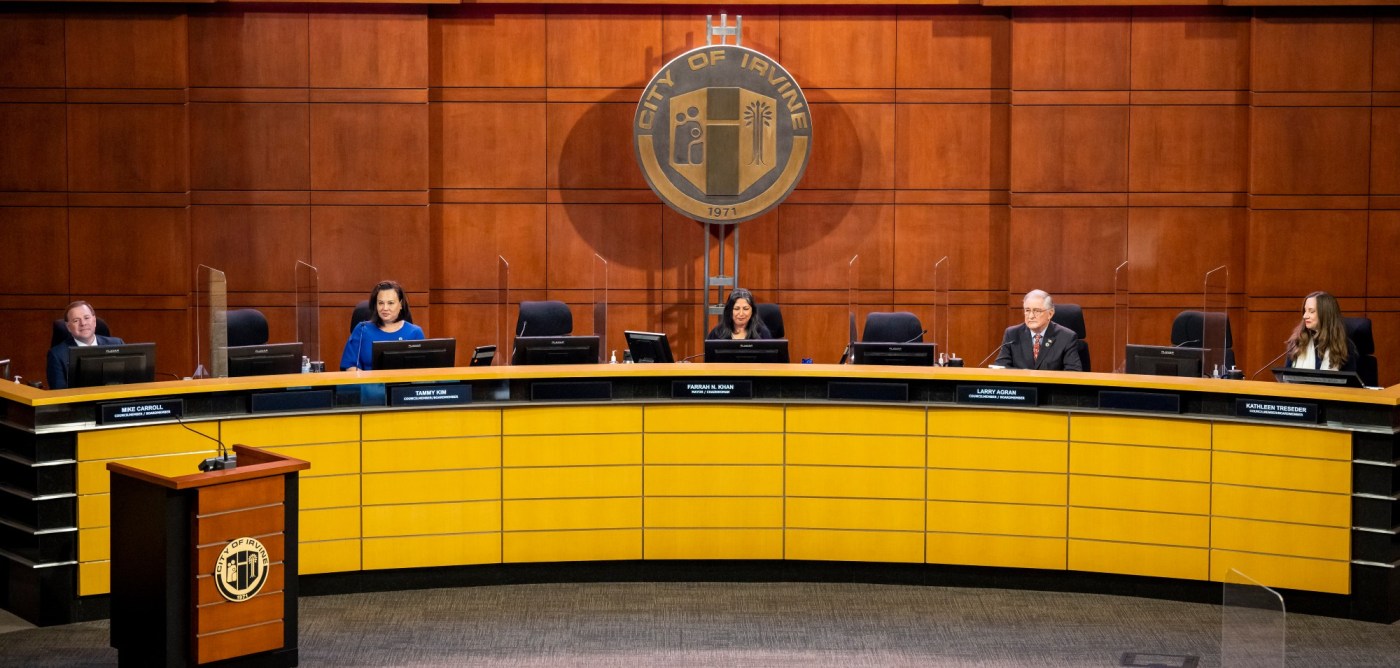The Irvine City Council is taking inventory of the city’s security cameras as the first part of its preliminary planning for more security cameras in public spaces.
The council was unanimous in its decision earlier this month, directing city staff to submit a report of the number of cameras currently in operation as well as public spaces in Irvine that may need security cameras.
“This is really about our shared goal,” said Councilmember Tammy Kim. “What we all want is to create a secure environment where our residents can live their lives, work and raise their families without the constant worry of safety.”
Security cameras, Kim said, can provide surveillance, deterrence and evidence gathering.
Irvine utilizes several types of cameras: traffic cameras, facility cameras, investigations cameras and roving cameras, according to city staff.
The primary purpose of each of these cameras is distinct. Traffic cameras — not to be confused with red-light cameras that photograph and fine drivers running red lights — assist in traffic operations, including managing traffic flow and signaling timing. They are deployed as real-time management tools and do not record video footage, although public safety staff within the Orange County Communications Center can manually capture video of significant incidents, like a car chase, for evidentiary purposes. Facility cameras, managed by the Department of Public Safety, exist to monitor facility grounds and capture video only.
License plate recognition systems, an example of an investigation camera, automatically read license plates and compare them against a database of known suspect vehicles. These units are installed at the Civic Center to “bolster facility security,” according to city staff, and can quickly identify wanted vehicles entering or leaving the parking lot.
And roving cameras are body-worn by public safety personnel that capture both audio and video. The city’s public safety department has 312 chest-mounted roving cameras for field personnel and 42 helmet-mounted for the SWAT team and officers on motorcycles.
While traffic cameras are being operated in 347 intersections across the city, facility cameras are only in three locations: the Irvine Transportation Center, Great Park and the Civic Center. The Civic Center, where City Council meetings are held, has a total of 135 cameras while the Irvine Transportation Center has 20 and Great Park has 88.
The senior center, as well as Heritage Community Park, are two places where the Department of Community Services is considering adding facility cameras, city staff said during the Aug. 8 meeting.
A majority of residents who spoke during the meeting were in favor of adding more security cameras around the city — given it’s done in a way that respects personal privacy. One University High School senior, who said he’s lived in Irvine for over 15 years, said he felt safe in the city until he saw a video on Instagram a few months ago of people threatening shoppers at the Spectrum Center.
Police Chief Michael Kent said cameras “absolutely help” in preventing and solving crime. The cameras’ technology, said Kent, is what helped the Irvine Police Department apprehend the three murder suspects of the fatal car-to-car shooting of a 19-year-old man in Irvine earlier this month.
Under the police department’s policy, video surveillance must be conducted exclusively in public areas where there is no expectation of privacy, Lt. Frough Jahid said. Monitoring is also limited to public activities, and the city’s chief of police must approve the cameras’ proposed locations.
But while the presence of cameras may act as a “deterrent dissuading potential criminal activity,” cameras are expensive, Jahid said.
In order to help offset the cost of the new cameras and software to monitor footage, city staff said the Department of Public Safety seeks various funding opportunities, including a Board of State and Community Corrections’ organized retail theft prevention grant.
Though the city has yet to find out if the requested $5.4 million will be awarded, the money would cover three years of funding for four staff members, hardware, video analytics and software.
Irvine also received nearly $3 million through the state budget to establish a real-time crime center and equip it with new hardware and software; though this is not directly related to the city’s potential plan to add more security cameras.
Councilmember Larry Agran said while he would be supportive of more security cameras if they can be shown to truly deter or defeat criminality, more data is necessary to make a decision.
“This raises a pretty basic question about whether we’re actually creating a creeping surveillance state or municipality here, which makes people very uncomfortable,” Agran said.
Kim said it’s important to have “respect for transparency and rights for individuals at the forefront of all the decisions” the council makes.
Related Articles
Calls growing from elected officials for resignations of any Anaheim city leaders helped plan mock council meeting
Anaheim mayor calls for resignation of any city leaders who helped plan mock council meeting
Irvine plans to make sustainability the heart of Great Park
Anaheim council wants to explore cutting off funding for Visit Anaheim
Anaheim residents call for transparency, reforms at council’s first meeting following probe results




